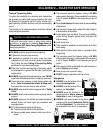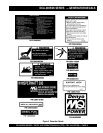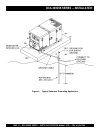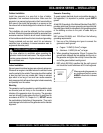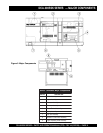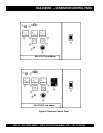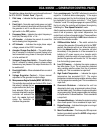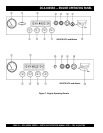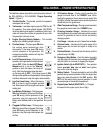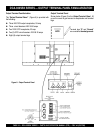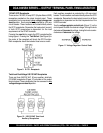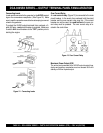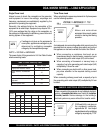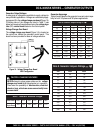
DCA-300SSK SERIES — PARTS AND OPERATION MANUAL (STD)— REV. #4 (03/27/06) — PAGE 21
The definitions below describe the controls and functions of
the DCA-300SSK
“Control Panel”
(Figure 8).
1. Pilot Lamp – Indicates that the generator is working
properly.
2. Panel Light – Normally used in dark areas or at night
time. When activated, panel lights will illuminate. When
the generator is not in use be sure to turn the panel
light switch to the OFF position.
3. Frequency Meter – Indicates the output frequency in
hertz (Hz). Normally 60 Hz ±1 Hz .
4. AC Ammeter – Indicates the amount of current the
load is drawing from the generator.
5. AC Voltmeter – Indicates the single phase output
voltage present at the UVWO terminals.
6. Ammeter Change-Over Switch – This switch allows
the AC ammeter to indicate the current flowing to the
load connected to any phase of the output terminals,
or to be switched off.
7. Voltmeter Change-Over Switch – This switch allows
the AC voltmeter to indicate phase to phase voltage
between any two phases of the output terminals or to
be switched off.
8. Panel Light Switch – When activated will turn on control
panel light.
9. Voltage Regulator Control – Allows manual
adjustment of the generator’s output voltage.
10. Microprocessor Engine Controller (MPEC S/N 3701674~)
This controller has a vertical row of status LED's (inset),
that when lit, indicate that an
engine malfunction (fault), has
been detected. When a fault
has been detected the engine
controller will evaluate the
fault. Any
major
fault will
cause the controller to
shutdown the generator.
DCA-300SSK — GENERATOR CONTROL PANEL
During
cranking cycle
, The MPEC will attempt to crank the
engine for 10 seconds before disengaging. If the engine
does not engage (start) by the third attempt, the engine will
be shutdown by the engine controller’s " Over Crank
Protection" mode. If the engine engages at a speed (RPM's)
that is not safe, the controller will shutdown the engine by
initializing the "
Over Speed Protection
" mode.
Also the engine controller will shutdown the generator in the
event of low oil pressure, high coolant temperature, low
coolant level, and loss of magnetic pickup. These conditions
can be observed by monitoring the LED status indicators on
the front of the controller module.
A. Off/Manual/Auto Switch – This switch controls the
running of the generator. If this switch is left in the "OFF"
position, the generator will not run. When this switch is
set to the
manual
position, the generator will start
immediately. If the generator is to be connected to a
building's AC power source via a transfer switch
(isolation), place the switch in the
auto
position. In this
position the generator will monitor the AC line output
from the building's power source.
B. Low Oil Pressure – Indicates the engine pressure
has fallen below 15 psi. The oil pressure is detected
using variable resistive values from the oil pressure
sending unit. This is considered a
major
fault.
C. High Coolant Temperature – Indicates the engine
temperature has exceeded 215°F. The engine
temperature is detected using variable resistive values
from the temperature sending unit. This is considered a
major
fault.
D. Overcrank Shutdown – Indicates the unit has
attempted to start a pre- programmed number of times,
and has failed to start. The number of cycles and duration
are programmable. Typical programmable start settings
is 3 cycles with a 10 second duration . This is considered
a
major
fault.
E. Overspeed Shutdown – Indicates the engine is running
at an unsafe speed. This is considered a
major
fault.
F. Engine Running – Indicates that engine is running at
a safe operating speed.
11. Main Circuit Breaker – This three-pole, 800 amp main
breaker is provided to protect the UVWO voltage output
terminals from overload.



